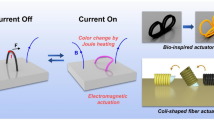Abstract
We present a kirigami-inspired design scheme for a robotic hand by 3D printable folds and cuts. The unique contribution is the printable flexible hand, which provides flexibility and maneuverability that is unavailable in rigid robotic systems. The integration of sensors in the robotic system enables force adjustment for robotic systems applicable in the future. The experimental results have shown that this design can perform everyday tasks through grasping and pinching different items. The fingers can bend from 40 to 100 degrees. Furthermore, the direct printable kirigami cuts and folds from soft elastic printable materials have significant potential for prosthetic devices. The printable kirigami design framework opens the possibility for future developments and modifications in numerous robotic applications.











Similar content being viewed by others
References
Lu, W. L., Zhou, P., Zheng, S. B., & Xue, D. (2017). A survey on the current status of rehabilitation services and burnout of rehabilitation professionals in Shanghai. Work, 56(2), 319–325.
Chan, Y.H., Tse, Z., & Ren, H.L. (2017). Design evolution and pilot study for a kirigami-inspired flexible and soft anthropomorphic robotic hand. In 2017 18th International Conference on Advanced Robotics (ICAR) (pp. 432–437). IEEE.
Majidi, C. (2014). Soft robotics: A perspective—current trends and prospects for the future. Soft Robotics, 1(1), 5–11.
Polygerinos, P., Lyne, S., Wang, Z., Nicolini, L. F., Mosadegh, B., Whitesides, G. M., & Walsh, C. J. (2013). Towards a soft pneumatic glove for hand rehabilitation. In 2013 IEEE/RSJ International Conference on Intelligent Robots and Systems (pp. 1512–1517). IEEE.
Polygerinos, P., Wang, Z., Galloway, K. C., Wood, R. J., & Walsh, C. J. (2015). Soft robotic glove for combined assistance and at-home rehabilitation. Robotics and Autonomous Systems, 73, 135–143.
Noritsugu, T., Takaiwa, M., & Sasaki, D. (2008). Power assist wear driven with pneumatic rubber artificial muscles. In 2008 15th International Conference on Mechatronics and Machine Vision in Practice (pp. 539–544). IEEE
Mozaffari Foumashi, M., Troncossi, M., & Parenti Castelli, V. (2011). State-of-the-art of hand exoskeleton systems.
Johnson, M., Chen, Y., Hovet, S., Xu, S., Wood, B., Ren, H., Tokuda, J., & Tse, Z. T. H. (2017). Fabricating biomedical origami: A state-of-the-art review. International Journal of Computer Assisted Radiology and Surgery, 12(11), 2023–2032.
Song, Z. (2016). Studies of origami and kirigami and their applications. Arizona State University
Rossiter, J., & Sareh, S. (2014). Kirigami design and fabrication for biomimetic robotics. In Bioinspiration, Biomimetics, and Bioreplication 9055, 90550G). International Society for Optics and Photonics
Schenk, M., Guest, S.D. (2011). Origami folding: A structural engineering approach. In Origami 5: Fifth International Meeting of Origami Science, Mathemat- ics, and Education, pages 291–304. CRC Press, Boca Raton, FL.
Obi, O. F. (2016). Hand anthropometry survey of rural farm workers in south-eastern Nigeria. Ergonomics, 59(4), 603–611.
Ladda, R., Bhandari, A. J., Kasat, V. O., & Angadi, G. S. (2013). A new technique to determine vertical dimension of occlusion from anthropometric measurements of fingers. Indian Journal of Dental Research, 24(3), 316.
Chen, C. F., Appendino, S., Battezzato, A., Favetto, A., Mousavi, M., & Pescarmona, F. (2013). Constraint study for a hand exoskeleton: Human hand kinematics and dynamics. Journal of Robotics, 2013, 910961
Li, M., Zhuo, Y.Y., He, B., Liang, Z.T., Xu, G.H., Xie, J., & Zhang, S.C. (2019). A 3D-printed soft hand exoskeleton with finger abduction assistance. In 2019 16th International Conference on Ubiquitous Robots (UR) (pp. 319–322). IEEE
Yu, S.Y., Perez, H., Barkas, J., Mohamed, M., Eldaly, M., Huang, T. H., Yang, X.L., Su, H., Cortes, M.M, & Edwards, D. J. (2019). A soft high force hand exoskeleton for rehabilitation and assistance of spinal cord injury and stroke individuals. In Frontiers in Biomedical Devices 41037, V001T09A011. American Society of Mechanical Engineers.
Sarac, M., Solazzi, M., Sotgiu, E., Bergamasco, M., & Frisoli, A. (2017). Design and kinematic optimization of a novel underactuated robotic hand exoskeleton. Meccanica, 52(3), 749–761.
Yun, Y. M., Dancausse, S., Esmatloo, P., Serrato, A., Merring, C. A., Agarwal, P., et al. (2017). Maestro: An EMG-driven assistive hand exoskeleton for spinal cord injury patients. In 2017 IEEE International Conference on Robotics and Automation (ICRA) (pp. 2904–2910). IEEE.
Bajaj, A., Jain, V., Kumar, P., Unal, A., & Saxena, A. (2021). Soft hand exoskeleton for adaptive grasping using a compact differential mechanism. In Mechanism and Machine Science (pp. 733–746). Springer, Singapore.
Lipson, H. (2014). Challenges and opportunities for design, simulation, and fabrication of soft robots. Soft Robotics, 1(1), 21–27.
du Plessis, T., Djouani, K., & Oosthuizen, C. (2021). A review of active hand exoskeletons for rehabilitation and assistance. Robotics, 10(1), 40.
Fu, C., Xia, Z., Hurren, C., Nilghaz, A., & Wang, X. (2022). Textiles in soft robots: Current progress and future trends. Biosensors and Bioelectronics, 196, 113690.
Garcia, L., Kerns, G., O’Reilley, K., Okesanjo, O., Lozano, J., Narendran, J., et al. (2022). The role of soft robotic micromachines in the future of medical devices and personalized medicine. Micromachines, 13(1), 28.
Shahid, T., Gouwanda, D., Nurzaman, S. G., Gopalai, A. A., & Kheng, T. K. (2021). Development of an electrooculogram-activated wearable soft hand exoskeleton. In 2020 IEEE-EMBS Conference on Biomedical Engineering and Sciences (IECBES), (pp. 433–438). IEEE.
Pérez Vidal, A. F., Rumbo Morales, J. Y., Ortiz Torres, G., Sorcia Vázquez, F. D. J., Cruz Rojas, A., Brizuela Mendoza, J. A., & Rodríguez Cerda, J. C. (2021). Soft exoskeletons: development, requirements, and challenges of the last decade. In Actuators 10(7), 166. Multidisciplinary Digital Publishing Institute.
Li, M., Chen, J. Z., He, G., Cui, L., Chen, C., Secco, E. L., & Wurdemann, H. (2021). Attention enhancement for exoskeleton-assisted hand rehabilitation using fingertip haptic stimulation. Front Robot AI, 8, 144.
Acknowledgements
This work was supported by Singapore Academic Research Fund under Grant R397000353114.
Author information
Authors and Affiliations
Corresponding author
Ethics declarations
Conflict of interest
Each of the authors (Y Chan, Z Tse, H Ren) declare that there is no conflict of interest.
Rights and permissions
About this article
Cite this article
Chan, Y., Tse, Z.TH. & Ren, H. Printable Kirigami-inspired Flexible and Soft Anthropomorphic Robotic Hand. J Bionic Eng 19, 668–677 (2022). https://doi.org/10.1007/s42235-022-00182-4
Received:
Revised:
Accepted:
Published:
Issue Date:
DOI: https://doi.org/10.1007/s42235-022-00182-4




